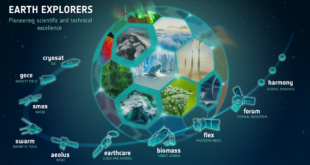
By Alessandra Albano
The global space industry is expected to generate revenue of US$1.1 trillion or more in 2040, up from the current US$350 billion, according to Morgan Stanley. Investors are also taking an upbeat view of the prospect of investing in space innovations amidst the risk of technical recession. According to Space Investment Quarterly, US$1.7 billion in equity was invested into space companies – nearly double the amount invested in the last quarter of 2018.
While space is no doubt the next frontier for business innovation, for the commercial space industry to continue growing, value can be created by unlocking what satellites capture. From Earth Observation (EO) data to Internet of Things (IoT) tracking and communication metadata, businesses can someday leverage space technologies in the most profitable, efficient and safe way possible. This SpaceWatchGL Opinion by Alessandra Albano of SpaceChain details the development of space technologies and how its merger with blockchain makes safe, scalable and value-enhancing data sharing possible in terrestrial networks.
Containerization is an oftentimes underappreciated breakthrough in the global shipping industry. The concept was as simple as revolutionary: anything that needed to be moved from one place to another was to be put inside a robust metal box of a precisely agreed size, shaped in such a way as to allow for safe stacking and locking on transportation vehicles, from specially designed ships to lorries. Between the 1960s and ‘70s, containerization was pivotal to boosting the global economy by standardising how goods were moved across the globe, increasing the speed of commerce, igniting the creation of new industries and fostering the transformation of existing ones. Built on shared and agreed-upon standards, this was an inherently trusted way to share resources, maximise efficiency and minimise costs. The global economy could finally scale up.
Arguably, space is at the doors of a commercial revolution similar to the one enabled by containerization, but standards in the space industry so far have been created and adopted principally to ensure safety, for example when launching and tracking satellites in order to avoid collisions. The commercial potential for the space industry and the wider global economy lies in space applications, which create value off its primary resource: data. These are the ‘goods’ that the New Space Economy will need to transport safely, and within a context of shared trust. In other words, it will be in applications of space data that we will generate value in the New Space Economy.
Standardizing the Commercial Space Industry
For the commercial space industry to grow and generate scalable value, it will need to scale through standardised, repeatable practices and through cost-effective operations that will enable the data to be created and shared in a profitable way through predictable mechanisms to exchange value. This is to say that value exchange can happen only by unlocking the value of what satellites capture, from Earth Observation (EO) data to Internet of Things (IoT) tracking and communication metadata, and leverage it in the most profitable, efficient and safe way possible.
This starts by creating new opportunities to maximise the use and the efficiency of commercial space resources. Three areas where this can happen are the use of commercial-off-the-shelf (COTS) components; the adoption of open-source (openly auditable, free to use and collectively built) software; and the embedding of blockchain technology in space hardware and software. Adopting manufacturing standards in payload specifications and dimensions will ensure “stackability” and fast turnaround for new commercial launches, something that can also be extended to how space software is built. In addition, the increased adoption of COTS components paired with open-source software has the potential to speed up vetting and increase reliability if paired with appropriate quality assurance processes. These processes are otherwise bespoke, costly and lengthy, and the adoption of code and components that have already been approved both lowers risks and makes the process easier and cheaper for the industry.
The development of standards for payload manufacturing, the adoption of COTS and the use of open-source software will all contribute to building a shared infrastructure that will make space an increasingly commercially viable and scalable addition to existing terrestrial businesses, as well as open up new ventures that are entirely space-based (monetizable applications built on space data). This however will not be sufficient to mobilize the resource value, the data.
A Question of Trust
To explain this using the containerization revolution as an analogy, for the New Space Economy to thrive it will need an incremental step that not only requires the standardisation of the containers and how they are moved, but also how the goods inside each container are monetized while in transit, and this only if the owner of the goods consents, benefits financially and does not incur unmitigated risks.
Just as containerization was required to build shared trust among the participants in the global economy for it to scale, scaling up the New Space Economy requires trusted data sharing which is a new ball game altogether. Monetization of (curated and) pooled digital resources will form the basis of the New Space Economy but trust will remain a barrier unless shared platforms will allow data owners to retain control over how data is shared while keeping the risks associated with data sharing low. It will also be necessary to make the data sharing process scalable, by finding a way to make it repeatable, by minimizing red tape and by ensuring that the value of the data does not reduce or vanish after it is shared.
How Blockchain Technology Creates Trust
The technology that makes safe, scalable and value-enhancing data sharing possible in terrestrial networks is blockchain, thanks to its inherent properties: a tamper-resistant ledger that requires digital signatures, technologically enforceable contracts and a distributed consensus. Blockchain ensures that data remains an asset and any sharing of data is transparent and verifiable.
Blockchain is very simply a chain of blocks, where a ‘block’ is digital information that is stored in a database (a chain) that is publicly auditable and that is incredibly hard to corrupt (if well designed and deployed). Blocks can only be added (append-only, no block can ever be deleted), and a new block can be added only if all the participants (nodes) in the network agree that the previous blocks have not been manipulated. Each new block, identified with a cryptographically generated number (a hash), also stores information about the date, the time and the unique identifier of the entity wanting to add the new block. Blocks can contain instructions (smart contracts) in the form of conditions ‘if-then’, hard-coded into the platform and self-enforcing once the conditions are met.
It is widely accepted that blockchain technology increases transparency because it allows for each transaction to be traced and audited by authorised parties in case of private (permissioned) blockchains and in case of a public (permissionless) blockchain, by anyone with access to the ledger. This creates a controlled, trusted environment that didn’t exist before for all the willing data-sharing participants.
Governed by economic incentives and distributed consensus, blockchain is often referred to as a ‘trustless’ system because the technology itself takes the role of trusted intermediary, or in other words, the technology disintermediates any central party who would normally be needed to validate the value exchange.
Using Blockchain for Space Applications
Blockchain’s smart contracts can be leveraged as the digital root of trust for satellites authenticating into a network, using a list of authorised public keys to tell which satellites should be or should not be part of the network, and using distributed consensus to enforce it. In addition, a company wishing to share proprietary data using a blockchain-enabled network could program into the smart contracts which data-sharing requirements are mandatory to allow the transaction, such as the identity of the data acquirers and the list of approved uses of the data. The entity wanting to access the data must authenticate itself within the platform and declare the conditions set to authorize the transaction, which only then will be executed according to the terms coded into the smart contract to provide access to the data.
Blockchain can also empower data-sharing without the transference of source data in what is referred to as in-situ data mining or federated learning, with algorithms that ‘travel’ to the data without being able to access all of the data unless permission is granted, and without being able to copy or move the data during the training process. This allows participants to draw insights from larger and protected datasets without compromising their security or threatening individual commercial interests and privacy. In addition, where commercial, security or other factors require prior whitelisting of the parties allowed to access the ledger, this can be set to be private (permissioned blockchain). For example, it can be programmed to authorize only regulators and approved auditors to read certain parts of the ledger.
For satellite networks, embedding blockchain technology within payloads may mean eventually drastically minimize the need, constraints and risks associated with ground station to satellite communication and enable satellite-to-satellite curation, computation and data sharing. Within a network of satellites with blockchain-enabled payloads therefore, data sharing can be executed without needing any centralised third party to handle and confirm the data exchange.
Should the implementation of a wholly permissionless blockchain-based satellite network become a reality, then a wider and more diverse range of participants would be able to join in such network as long as they meet the criteria set, no single entity having the power to shut down the network or veto the participation from authorized and validated parties. A peer-to-peer distributed network in space could be built with mechanisms that create technologically-incentivised trust, thus removing many of the barriers to cooperation that currently prevent scaling up of large multi-jurisdictional multi-entity commercial collaborations.
Towards a Scalable New Space Economy
This sets the scene for more distributed access to space infrastructure. Blockchain-enabled payloads can empower the New Space Economy by unlocking the value of satellite-generated data in a safe and open way, and enable a new generation of space networks. At the doors of a commercial revolution for the space industry and together with the development of standards in payload manufacturing, the adoption of COTS and the use of open-source software, blockchain will play a pivotal role in mobilizing the commercial potential for space applications, similarly to how containerization powered the post-war global economy.

Alessandra Albano is Chief Operating Officer (COO) for SpaceChain. Alessandra has been advising blockchain projects since 2017 and joined SpaceChain after having been COO of DEX, a decentralised data exchange, and having been part of the founding team at Ocean Protocol, in charge its ecosystem growth and operations. An Oxford Said Business School and INSEAD executive programs alumna, Alessandra specialises in sustainable growth strategies and operational excellence. She brings with her a wealth of experience in managing high-value contracts and large-scale teams in different sectors and at global level. As one of the pioneers in tokenization, she is an established thought leader in ecosystem growth, she’s a published author and the founder of AcchaLabs.ai, a company that advises traditional companies on incorporating tokenization in their business model through incremental innovation. Boasting more than a decade of experience in leading operations and marketing between Europe, India and Asia, Alessandra is in charge of SpaceChain’s global operations and strategy, and leads its ecosystem growth.





